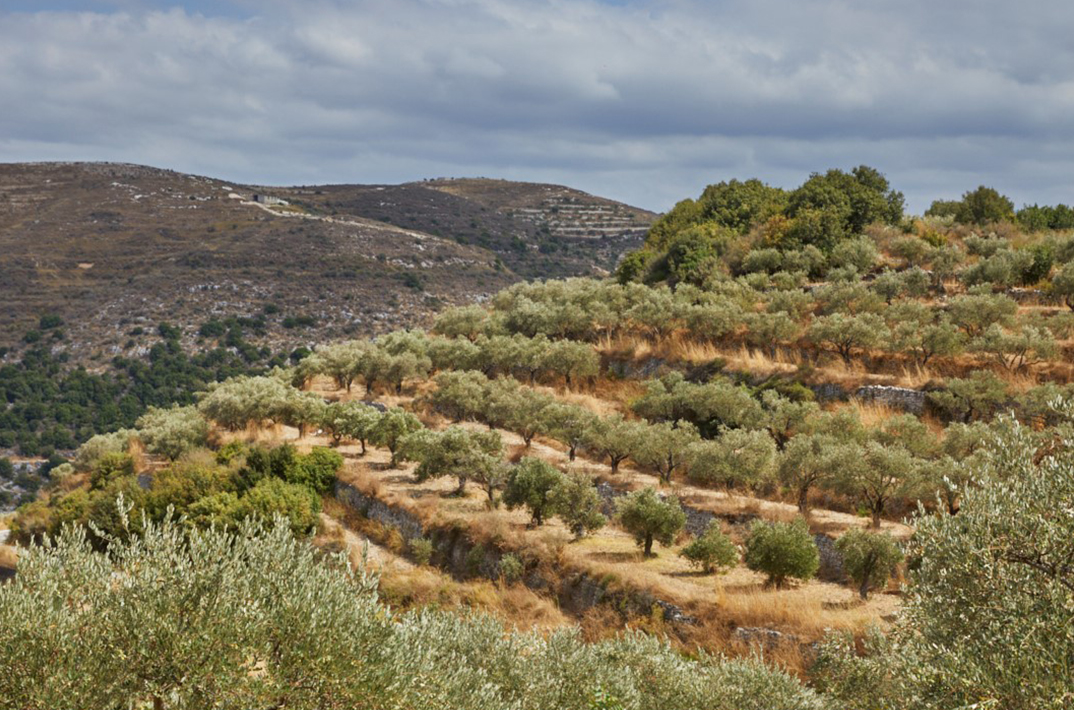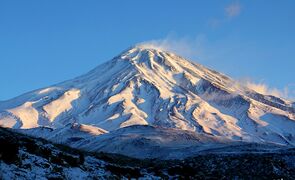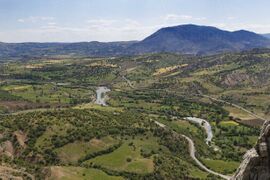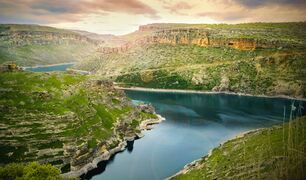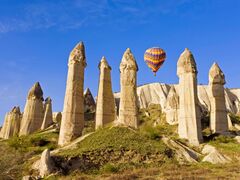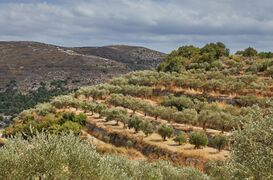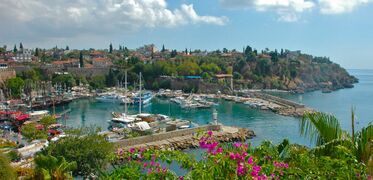Mesogeia: Difference between revisions
| Line 179: | Line 179: | ||
Winters can vary across the country, but they are generally mild to cold and wet, with snowfall in the north and along the highest mountain ranges and plateaus. Summers can be hot and dry with frequent thunderstorms throughout the country. The highlands are generally cooler in the summer as a result of their high elevation. May is generally the wettest month of the year while July and August are the driest on average. The spring and Autumn months in the country are more mild. | Winters can vary across the country, but they are generally mild to cold and wet, with snowfall in the north and along the highest mountain ranges and plateaus. Summers can be hot and dry with frequent thunderstorms throughout the country. The highlands are generally cooler in the summer as a result of their high elevation. May is generally the wettest month of the year while July and August are the driest on average. The spring and Autumn months in the country are more mild. | ||
[[File:Olive groves in central Isauris]] | [[File:Olive groves in central Isauris.jpeg]] | ||
[[File:Forests of Voreiastan.jpg]] | [[File:Forests of Voreiastan.jpg]] | ||
| Line 190: | Line 190: | ||
File:The Aranz river.jpg| Aranz River flows through the country's interior | File:The Aranz river.jpg| Aranz River flows through the country's interior | ||
File:Korama national park1.jpg| Fairy chimneys in Korama National Park in Katapatuka satrapy. | File:Korama national park1.jpg| Fairy chimneys in Korama National Park in Katapatuka satrapy. | ||
File:Olive groves in central Isauris. | File:Olive groves in central Isauris.jpeg|Olive groves in the Isauris satrapy a region notable for its extensive farmland. | ||
File:Forests of Voreiastan.jpg| Forests in northern Mesogeia, Voreiastan satrapy. | File:Forests of Voreiastan.jpg| Forests in northern Mesogeia, Voreiastan satrapy. | ||
File:Mesogeian Riviera beach resorts.jpg| the Mesogeian riviera (in Phocaea) along the southern coastline is the site of various beach resorts | File:Mesogeian Riviera beach resorts.jpg| the Mesogeian riviera (in Phocaea) along the southern coastline is the site of various beach resorts | ||
Revision as of 01:10, 25 January 2024
This article is incomplete because it is pending further input from participants, or it is a work-in-progress by one author. Please comment on this article's talk page to share your input, comments and questions. Note: To contribute to this article, you may need to seek help from the author(s) of this page. |
Empire of Mesogeia Βασιλεία Μεσογεια | |
|---|---|
| Motto: "Omnis mundus Mesogeiae subiecta est" (Mesogeian) "All the world is subject to Mesogeia!" | |
| Anthem: God's Grace Aids the Emperor! | |
| Capital | Alexandropolis |
| Official languages | Mesogeian |
| Demonym(s) | Mesogeian |
| Government | Federal republic with a semi-autocratic monarchy |
• Empress | Elena II |
| TBD | |
| Legislature | Parliament |
| Gerousia Magistan | |
| Chamber of Poleis Chora Assembly | |
| Area | |
• | 843,360 km2 (325,620 sq mi) |
| Population | |
• 2020 census | 85,326,490 |
| GDP (PPP) | 2020 estimate |
• Total | $1.754 trillion |
• Per capita | $20,560 |
| GDP (nominal) | 2020 estimate |
• Total | 1.601 trillion |
• Per capita | $18,765 |
| Gini (2018) | high |
| HDI (2020) | high |
| Currency | Mesogeian Drachma (₯) |
| Date format | dd.mm.yyyy |
| Driving side | right |
| Calling code | 31 |
| ISO 3166 code | MESO |
| Internet TLD | .MES |
Mesogeia, officially known as the The Guarded Domains of the Most Sublime Empire of the Central State, or interchangably as The Guarded and Most Sublime Empire of Mesogeia, and most commonly and simply as The Mesogeian Empire short is a sovereign nation located in the world on the subcontinent of TBA, the easternmost portion of the continent of Belisaria, sharing a western border with Greznea and Ludvosyia, a eastern border with TBA, and southern maritime borders with Uluujol and Kocisupara. Mesogeia's name means the "middle land", and it was often known as "The Middle Kingdom" implying the long held belief of Mesogeians that Mesogeia was the center of the world. The Mesogeian empire comprises an area of 843,360 km2 (325,620 sq mi), with an estimated population of 85 million people.
The Empire of Mesogeia is considered to be an absolute monarchy by tradition, while in practice it is federal parliamentary republic presided over by a nominally constitutional monarch. The current monarch is Empress Elena II, who has reigned since 1962, making her one of the longest reigning monarchs in Mesogeian history.
Mesogeia's capital and largest city is Alexandropolis; which is also a major political, cultural, and economic centre. Other major urban centers include Pharopoli, Parisia, Chrysopolis, Anaitis, and Farsargadai.
The official language of the empire is the Aerionese (the Mesogeian-Azagartian dialect) language which serves as the language of instruction and is spoken throughout the nation particulary in rural areas and in the north and northeast, while the Mesogeian Hellenic (called Alcaenian) language is spoken at the Imperial court, by the high nobility, the military establishment, and mainly in major urban centers in the south. The third major language of the empire the Tauric language (with its northern and southern dialects) is spoken mainly in the empire's interior and far north.
Other regional languages include Transigozanian in the north-east, Ardistanian in the interior, and Paralian on the eastern fringes of the empire. In addition to this Latin, Audonian, Arthuristan Anglic, and other Belisarian languages are spoken in major metropolitan areas.
Mesogeia is a developed country with a large and diversified economy. The Empire of Mesogeia has a high quality of life, and high living standards. Mesogeia is a regional power with notable cultural, diplomatic, economic, military, political, and scientific, influence. Mesogeia is home to one of the oldest civilizations in the world. As a result of its rich cultural history, Mesogeia is the site of close to 50 Forum of Nations heritage sites.
The country has been criticized however for a number of reasons, including but not limited to its eastern and western culture clash particularly its fusion of eastern absolutism and western democratic principles, the perceived favoritism of Hellenic culture over others in the government, social inequality, a significant wealth gap, the church's role in government, perceived decadence, the extreme complexity of its bureaucracy and Imperial court, in addition to a reliance on the nobility and members of the social elite and upper middle class to fill the government and bureaucracy.
Etymology
The origins of the name of Mesogeia are several centuries older then the country itself. The exact origin of the term Mesogeia is shrouded in mystery dating back at least six thousand years. Legends state that the original inhabitants believed Mesogeia to be the centre of the world proclaiming it to be the middle land or Meso gei, as it became known. Eventually the area settled by the ancestors of the modern Mesogeians became known as Mesogeia.
History
Prehistory
The earliest archeological evidence in the territory that is modern Mesogeia is dated to about 2.1 million years ago. In the early twentieth century archeologists discovered the remains of the oldest recorded hominid to reside in what is now Mesogeia, in a cave in the modern province of Pharosia.
The hominid fossils of a Homo Erectus were discovered in the central province of Mesaia, archeologists have even dated between 710,000 and 830,000 years ago. Meanwhile in the region of what constitutes the modern province of Morea the remains of Homo sapiens were unearthed (dated to 250,000 and 125,000 years ago). Several hunter gather societies are attested between the 14th and 9th millennia BC living around the major waterways of the region. The earliest established settlements in Mesogeia are dated to this period.
Between the 9th and 4th millennia BC, a wide range of changes occurred in which the largely hunter-gather societies of Mesogeia transitioned into agricultural society residing in settled towns and later cities. In the 9th millennia BC, the domestication of dogs, pigs, goats, and sheep occurred. In the succeeding millennia in Mesogeia archeological evidence suggests that agricultural produce such as wheat and barley. In the 7th millennia BC, cats were domesticated,. By the 6th millennia BC, cattle were domesticated, wine and cheese were first produced in the state. By the 5th millennia BC, agriculture was firmly established in central Mesogeia and was expanding; by the end of the millennia, beer and the wheel had been developed. By the 4th millenia BC an agricultural civilization was firmly established in what is southern and central Mesogeia. Mesogeian writing system originated in this period, as did several ancient Mesogeian states.
Ancient Mesogeia
Medieval Mesogeia
Early Modern Age
Modern Age
Geography and climate
Geography
The Empire of Mesogeia covers a total area of 843,360 km2 (325,620 sq mi), of which 2.4% is water. The land of Mesogeia consists of a mainland and a few outlying islands near the coast. The highest point in Mesogeia is Mount Ahura at 5,205m (17,076 feet), which is technically the tallest peak of the Dushwar mountains. The geography of Mesogeia is characterized by a plateaus in the north and east with its mountain ranges forming the Mesogeian highlands; with fertile river valleys and plains dominating the country's interior and southernmost regions; while dense forests characterized.
The southern regions of the empire are characterized by flat open plains and some of the most fertile land in the empire. The fertile valleys of the southermost portions of the empire give way to the Kokkinos mountains (sometimes called the Drakonian mountains) stretching from Morea, Mygdonia, and parts of Epeirosia.
The Mesogeian interior is notable for its incredible fertile soil, the result of the three great rivers the Aranz, the Mesene, and the Eupator bisecting the valley. The huge ancient city of Chrysopolis, an amalgamation of three cities lies on the banks of the Aranz river.
Moving east past the Aranz river, the fertile valleys give way once more to higher terrain, the famed Mesogeian highlands an eastern expansion of elevated hills and mountains known affectionally as the rooftop of Mesogeia. This area has two distinct plateaus, the Aerionese plateau in the north eastern section which is considered to be the power base of the Aerionese race and the Palydian highlands in the south eastern section of the Mesogian highlands which has been inhabited by Ardistanians, Palydians, Alcaenians, and all sorts of ethnic groups making the region a distinctly unique region of the empire. The imperial capital Alexandropolis, is located on the south eastern tip of Palydia.
The regions of the empire along its western frontiers and northernmost regions particularly the satrapies Marzbania, Vantagallia, Voreiastan are characterized by wooded forests and rolling hills. The Tauric islands, the only non-contiguous portion of the empire is characterized by rolling hills and dense forests.
In the far east of the Mesogeian empire lies the Kanahwar mountain range which has acted as a natural defense and stronghold for the country for centuries.
Mesogeia includes twelve major river systems, the aforementioned Aranz, Mesene and Eupator rivers in the interior, in addition to this there are the Astargatis, Marmarinos, Tryphon in the south west; the Eulaeus, Vazarka, Gondishapur, and the Artas rivers in the east; the Barbar and the Gozan rivers in the north.
The Astargatis river originating on the western borders of the empire, flows south towards the city of Pharopoli near the Pharosian delta in the southernmost region of the country. The Tryphon river once formed the traditional border between the southern and northern kingdoms.
The country contains both fresh water lakes, Euphratia, and Ishtar; as well as saline lakes which dry up each year.
Climate
The climate of Mesogeia can be defined into two distinct categories, coastal and interior climates. The coastal regions of Mesogeia are characterized by a typically Periclean climate. Some mountainous areas feature an alpine like climate contrasting with the prevailing Periclean climate of the southern part of country.
A continental climate distinct from the Periclean climate of the coast prevails in the country's interior, particularly around the Aerionese plateau, and the Mesogeian Highlands, as a result of mountain formations around the coast. The climate of Mesogeia varies from region to region the more north you go, but typically most regions of the empire north of the Mesogeian highlands have a particularly temperate climate.
Winters can vary across the country, but they are generally mild to cold and wet, with snowfall in the north and along the highest mountain ranges and plateaus. Summers can be hot and dry with frequent thunderstorms throughout the country. The highlands are generally cooler in the summer as a result of their high elevation. May is generally the wettest month of the year while July and August are the driest on average. The spring and Autumn months in the country are more mild.
File:Forests of Voreiastan.jpg
- Landscapes of Mesogeia
- Forests of Voreiastan.jpg
Forests in northern Mesogeia, Voreiastan satrapy.
- Rugged coastline in Mesogeia's south western borders.jpg
Politics
The Empire of Mesogeia is classified as a federal republic, with a semi-autocratic monarch, but the country possess strong democratic traditions and principals. Whereas the Emperor (or Empress in the case of the current monarch) of Mesogeia is considered to be an absolute monarch with ultimate powers by tradition, she is however a constitutional monarch by law as a result of an un-codified constitution known collectively as the Constitution of Mesogeia.
While being a federal state the central government is based in the capital city Alexandropolis which holds supreme power in the land. Elena II is the reigning Empress and head of state, while Giannis Theodorou is the head of government as Imperial Mesazon.
Despite possessing strong democratic traditions and principles, a partially elected parliament, and being self-described as a federal republic, with a semi-autocratic monarch in name and tradition, the country has been particularly criticised for the confusing nature of its governmental system which has been depicted as authoritarian and despotic, due in part to the government's insistence of utmost respect and deference to the monarch above all. Mesogeian historians first coined the term "Republican Absolute monarchy in the 19th century to refer to the perceived union of autocratic and democratic ideals in the Mesogeian government. While foreign historians and critics have labeled it a benevolent autocracy at best or a fragile balance resting on the whims of a "good monarch" checked only by the threat of mass insurrection.
With one such critic claiming the nation as being on the verge of political turmoil, claiming that it was only a matter of time before the nation's various conflicting political forces turn on each other. While others have called into question the lack of major political upheaval in the last fifty years or so, citing the historic precedents of rebellions, revolts, and palace coups as an example of the country's perceived penchant for violent revolts. While others have incorrectly claimed that the Mesogeian tradition of Khvarenah (the hereditary dynastic imperial glory that divinely ordains successive monarchs) opens the door for violent rebellion.
Government
The government of Mesogeia is divided into three branches, the legislature, executive and judicial branches. The Mesogeian legislature is unique for being composed of four houses. The legislative power is vested in the tetracameral Synedrion of Mesogeia. The Synedrion consists of four houses; the Gerousia of appointed and hereditary nobles (mainly from the southern provinces) as well as clergy from the state religion, the Magistan consisting of nobility (from the northern provinces) and clergy from the old religion, the Chamber of Poleis and the Chora Assembly is composed of people respectively drawn from the urban and rural areas by general election
The Mesogeian Synedrion meets in the Koinoneion Palace, one of the oldest imperial palaces in the country. The Mesazon of Mesogeia is the head of government, while the monarch is head of state. The position of Imperial Mesazon generally goes to the leader of the party or coalition commanding a majority (this is however not always the case) of the seats in the two lower houses, the Chora Assembly and Chamber of Poleis. The Emperor ceremonially invites the leader of the majority to form a government.
The country two major political parties are the People's Party and the National Democratic Party, both parties having their origins in the empire's ancient chariot racing teams, the blue (Vénetoi) faction and the green (Prasinoi) faction respectively.
Aside from the Synedrion, other governmental councils created to assist in the smooth runnong of the imperial adminstration include the Imperial Council of State, which acts as an advisory body consulting the emperor on important matters.
Military
The Mesogeian armed forces numbers some 379,300 active personnel along with 500,000 in the reserve forces. The armed forces of Mesogeia consists of four branches: the Imperial Army, Imperial Navy, Imperial Air Force, and the Imperial Guards.
Administrative divisions
The Empire of Mesogeia is divided into twenty-two Satrapies. The twenty-two satrapies are Aerion, Arran, Anatolia, Ardistan Epeiros Iberion, Isauris, Khvarvaran, Kyrenaika, Paralia, Pharosia, Phocaea, Marzbania, Morea, Mygdonia, Taurica, Transgozania, Traxiana, Troiana, Turchia, Vantagallia, and Voreiastan.
The Satrapies are further divided into about 200 hyparchia, which are further subdivided into 3,500 eparchia. The Eparchia are subdivided into over 10,000 or so municipalities, villages and communities known collectively as demos.
| № | Flag | Name | Translation | Capital | Area (km2) |
Population (31 December 2021) |
|---|---|---|---|---|---|---|
| 1 | File:FlagArran.png | Aerion | Αέριον/ایریون | Aspadana | X | X |
| 2 | File:FlagAerion.png | Anatolia | Ανατολία/آناتولی | Hydeis | X | X |
| 3 | File:FlagArdistan.png | Ardistan | Αρδιστάν/اردستان | Artaxata | X | X |
| 4 | File:FlagArran.png | Arran | Αρράν/آران | Gazaka | X | X |
| 5 | File:FlagEpeiros.png | Epeiros | Ήπειρος/اپیروس | Dyrrachion | X | X |
| 6 | File:FlagIberion.png | Iberion | Ιβηρίων/ایبریون | Chaldia | X | X |
| 7 | File:FlagIsauris.png | Isauris | Ίσαυρης/ایزوریس | Antiochi | X | X |
| 8 | File:FlagKhvarvaran.png | Khvarvaran | Χρυσόπολις/کریزوپولیس | Chrysopolis | X | X |
| 9 | File:FlagKyrenaika.png | Kyrenaika | Κυρηναϊκά/کیرنایکا | Kyrene | X | X |
| 10 | File:FlagParalia.png | Paralia | Παραλία/پارالیا | Autolycia | X | X |
| 11 | File:FlagPharosia.png | Pharosia | Φαρωσία/فاروسیا | Pharopoli | X | X |
| 12 | File:FlagPhocaea.png | Phocaea | Φώκαια/فوکیا | Lefkosia | X | X |
| 13 | File:FlagMarzbania.png | Marzbania | Μαρζμπάνια/مرزبانیا | Hebdomon | X | X |
| 14 | File:FlagMorea.png | Morea | Μορέας/مولكول | Anaitis | X | X |
| 15 | File:FlagMygdonia.png | Mygdonia | Μυγδονια/میگدونیا | Pella | X | X |
| 16 | File:FlagTaurica.png | Taurica | Ταυρικά/تاوریکا | Pantikapaion | X | X |
| 17 | File:FlagTransigozania.png | Transigozania | Τρανσιγοζανία/ماوراءالنهر | Marakanda | X | X |
| 18 | File:FlagTraxiana.png | Traxiana | Τραξιάνα/تراکسیانا | Nishapur | X | X |
| 19 | File:FlagTroiana.png | Troiana | Τροϊάνα/ترویانا | Parisia | X | X |
| 20 | File:FlagTurchia.png | Turchia | Τουρκία/تورچیا | Triaditza | X | X |
| 21 | File:FlagVantagallia.png | Vantagallia | Βανταγαλλία/وانتاگالیا | Lysimachia | X | X |
| 22 | File:FlagVoreiastan.png | Voreiastan | Βορειάσταν/ووریستان | Sistan | X | X |
Economy
Mesogeia has a mixed economy. In the modern age it is a highly developed country with a high standard of living. The Mesogeian economy comprises the raw materials & agricultural sector, (17.1%.), the manufacturing sector (40.1%), and the service sector (42.8%).
Mesogeia is well known for its shipping/shipbuilding, design, fashion, and agricultural industries. The shipping and marine related industry is a major player in the country's economy, accounting for a substantial percentage of the country's GDP. The agricultural sector of the country is surprisingly large for a developed country. Tourism also plays an important role in the country's economy with around 50 million annual tourists each year.
Agriculture
The agricultural and raw meterials related sector accounts for 17.1% of the Mesogeian economy; it is however a powerhouse nevertheless with the country being a major producer of several agricultural products including wheat, legumes, wine, olive oil, olives, cherries, tobacco, tea, lemons, pears, apricots, honey, strawberries, onions, figs, dates, grapes. Mesogeia produces a substantial amount of meat (poultry & beef) and dairy products to be a major exporter on the world stage.
A traditional regional sea-power, Mesogeia has a large fishing industry, and the nation is known for being one of the highest consumers of fish products in the world. Mesogeia has one of the world's largest fishing fleets, and the fish caught by Mesogeian fisherman accounts for a substantial portion of the world's fish.
Energy
Mesogeia has a substantial amount of natural gas and oil reserves, but the country does not produce enough to be self sufficient. As a result Mesogeia imports oil and gas from foreign countries due to being unable to access the untapped natural gas reserves.
The country is mineral rich with such mineral resources including copper, iron, gold, silver, and coal.
Since at least the mid 1980s, the Mesogeian government has looked for alternative energies to natural gas; as a result the country has invested heavily in nuclear power as well as renewable energies such as solar power, wind power, and hydroelectric power. Despite this the country is still reliant on non-renewable energy (accounting for 77%), with only a small portion of the country's energy consumption comes from renewable energy (around 16.4%)
Shipping industry
Mesogeia has a large and competitive shipping industry that plays major role in the country's economy. The ancient Mesogeians were a seafaring people and the empire of Mesogeia is considered to be a regional maritime power specifically in the Colchian sea; it should be noted that for centuries shipping has played an important role in the empire's economy. In the present age shipping remains an important part of the nation's economy, accounting for around 5% of the nation's GDP.
Over the course of the eighteenth and nineteenth centuries several businessmen have amassed fortunes in the shipping and shipbuilding industries, earning the nickname the millionaire industry
Tourism
Tourism is an important sector in Mesogeia's economy. Mesogeia is one of the most visited countries in the world, with 30-50 million annual tourists as of 2020. Mesogeia is home to fifty plus world heritage sites, and has several notable cities of cultural interest, including Alexandropolis, Parisia, Chrysopolis, Pharopoli, Anaitis, and Farsargadae.
The country's many beaches, seaside resorts, and rural picturesque villages are popular tourists destinations known for their tranquility and natural beauty.
Mesogeia's most visited landmarks include, in no particular order: Acropolis of Alexandropolis, Koinoneion Palace, Imperial Hippodrome, The Celestial City, Imperial Museums of the Hormisdaion, Hagia Triada Cathedral,Baths of Alcides, Cathedral of Hagia Aima, Imperial Necropolis of Farsargadae, Acropolis of Parisia, Fortress of Pella, Mausoleum of Aegai, Bithynian Valley Castles, the Four Great Fire temples, Apostolic church monasteries and so on.
Infrastructure
Demographics
Languages
The Mesogeian empire has a number of regional languages spoken throughout its territories, but Alcaenian and Aerionese function as national languages with more or less co equal status.
Ethnic groups
The empire of Mesogeia has long since been termed a multinational state with various ethnic groups residing in its borders since time innumerable. A foreign traveler to the empire at the turn of the 20th century remarked that the empire was the most ethnically heterogenous state in Belisaria, While critics of the empire have labled it a prison of the peoples, a metaphor for the various ethnic groups subjected to Helianic-Aerionese rule.
For centuries the dominant ethnic groups have been Farsians-Aparnians and Troianians and Alcaenians, with Palydians and later Tauric groups coming in a close third. With each group serving a traditional role in medieval Mesogiean society, with the Heliac-speaking Troianians and Alcaenians serving as a military elite, the Farsians and Aparnians filling the administration and civil service as a bureaucratic elite; and the third group the Palydians and Tauric peoples acting as mediators between the two groups and often filling roles in the imperial court, ranging from eunuchs, concubines, and pages in the Imperial Gynaikeion, guards in the imperial guards, and officials within the imperial court.
In the present day Farsians make up the largest ethnic group, followed by Palydians, Troianians, Alcaenians, Pharosians, Aparnians, Isaurians, Ardistanians, Ludics, Tauric and Oreineians, Khvars, Gresiy and other ethnicities.
Religion
There are several distinct religions in the Mesogeian Empire including Mesogeian Apostolic Church, Aethelism, and Fabrianism, and Mesogeian Polytheism. The largest religious denomination in Mesogeia is Christianity with the Mesogeian Apostolic Church forming the vast majority of Christians in the country. The Mesogeian Apostolic Church functions as the state church of the empire, having several privileges not afforded to other religions.
Major cities
Largest cities or towns in Mesogeia
Imperial Chancellery | |||||||||
|---|---|---|---|---|---|---|---|---|---|
| Rank | Province | Pop. | Rank | Province | Pop. | ||||
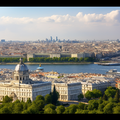 Alexandropolis 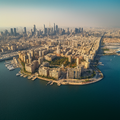 Pharopoli |
1 | Alexandropolis | Palydia, Mesogeia | 8,643,202 | 11 | Myrina | Troiana | 786,424 |  Parisia  Chrysopolis, |
| 2 | Pharopoli | Pharosia | 4,170,044 | 12 | Pella | Mygdonia | 768,196 | ||
| 3 | Parisia | Troiana | 3,862,331 | 13 | Lysimachia | Vantagallia | 730,266 | ||
| 4 | Chrysopolis, | Khvarvaran | 2,514,195 | 14 | Triaditza | Oreineia | 717,135 | ||
| 5 | Anaitis | Morea | 2,032,665 | 15 | Pergama | Troiana | 701,403 | ||
| 6 | Farsargadae | Aerion | 1,708,646 | 16 | Diospolis | Pharosia | 687,588 | ||
| 7 | Antiochia | Isauris | 1,283,154 | 17 | Aegai | Mygdonia | 670,494 | ||
| 8 | Chousa | Khvarvaran | 1,136,035 | 18 | Leftkosia | Phocaea | 639,034 | ||
| 9 | Alope | Troiana | 855,393 | 19 | Agbatana | Aerion | 631,155 | ||
| 10 | Aspadana | Aerion | 832,214 | 20 | Marakanda | Transigozania | 565,716 | ||
Eductation
State education in Mesogeia is free and compulsory from ages six to sixteen. Education in the country is overseen by the Imperial Ministry of Education and is divided into four stages: Nursery School (ages 4-6), primary school (ages 6-13), lower secondary (ages 13-15), upper secondary (15-18), and University. Mesogeia has a long history of education and it should be noted that the education of the nation's youth is valued highly in Mesogeian society.
Tertiary education in Mesogeia is divided between public universities, private universities and prestigious and very exclusive graduate schools and academies. There are a number of centers of higher learning in the country, including Mouseion University (which is the oldest having origins in antiquity), Pharopoli University (4th century BC), Antiochia University (4th century BC), Alexandropolis University (5th century AD), Gondishapur University (6th century), Chrysopolis University (8th century), Chousa University (10th century), University of Parisia (1130), Anaitis University (1436).
Mesogeia has a number of boarding schools, the most prestigious of which are Megaula College, Mieza College, Derkos College, and Edessa College.
Culture
The culture of Mesogeia has flourished for five thousand years of history. Mesogeia has developed a uniquely diverse culture, shaped by the cultures, customs, and traditions of various regional kingdoms and states that flourished in the area known as Mesogeia for centuries. The foundations for Mesogeian theology, mythology, philosophy, and literature all originated in the Avestic Period (c. 3100-800 BC) and the later Classical Period (c. 800 BC-547 AD). Mesogeia is notable for its cultural, religious, and ethnic diversity.
Art
Mesogeia has a rich artistic history, comprising many elements, including architecture, calligraphy ceramic art, icon painting, metalworking, mosaic art, painting, pottery, sculpture, stonemasonry, textile art, and weaving.
Architecture
Mesogeian architecture is the combined elements and characteristics of various cultures, states, and peoples preceding the modern Mesogeian Empire. Modern architecture of Mesogeia combines Farsian, Saracen, Aratianian, and Romaican influences to create an architectural style that is unique to Mesogeia. The history of architecture in Mesogeia goes back several millennia; and over the course of several centuries Mesogeian architecture has developed unique architectural designs that are both structurally and aesthetically pleasing.
Because Mesogeia is such a diverse country architectural styles vary from region to region in the empire, it should be known that the architectural styles predominate in northern Mesogeia can not be applied to southern Mesogeia.
Literature
Mesogeian literature has its origins in ancient Mesogeian states such as Pharosia and ancient Morea. With a history spanning several centuries, Mesogeian literature has given the world numerous writers, poets, philosophers, and historians, such as (PLACEHOLDER), (PLACEHOLDER), (PLACEHOLDER). The ancient Morean-Romaicans were also well known for their oral traditions, dramatic presentations of comedy and tragedy, pastorals, poetry, drama, epigrams, historiography, and philosophical treatises.
The Morean and Pharosian ancient kingdoms provided some of the earliest known literary works in the world. Historically Mesogeian literature can be divided into three main categories: Ancient literature, Medieval literature, and Modern Mesogeian literature.
Theatre
Mesogeian theatre is a synthesis of the ancient civilizations of Mesogeia. The modern Mesogeian theatre has its roots in the southern hellenic city-states of antiquity. The Mesogeian theatrical tradition were influenced by the ancient Lihnidosi. The Imperial Opera House in Alexandropolis is one of the oldest venues for modern theatrical performances having opened in 1735.
Philosophy
Mesogeian philosophy has its origins in antiquity dating back to 1500 BC. Mesogeian philosophy can be divided into three categories defined historically as Ancient Philosophy, Medieval Philosophy, and Modern Philosophy. As a result of unprecedented political and social changes, there exists in Mesogeia a wide range of Philosophical schools of thought, which uphold a variety of ideals rooted in the southern and northern regional differences.
Ancient philosophy refers to the philosophical traditions that emerged from the 15th century BC to the 5th century AD. There were several noteworthy Mesogeian philosophers including (PLACEHOLDER), (PLACEHOLDER), (PLACEHOLDER)
Medieval philosophy refers to the philosophical traditions that emerged from the 5th century AD to the emergence of early modern Mesogeia in the early 15th century. Philosophy during the medieval period can be further categorized between southern and northern schools of thought with Farsian philosophers dominating in the north and Hellenic philosophers holding influence in the south.
Philosophy after the 15th century refers to the modern age of Mesogeia, a period that differed greatly from the medieval age in various ways. The philosophy that followed took a modernist approach. Philosophers of the day believed that it was the destiny of Mesogeia to rule the entire subcontinent.
Philosophy in Mesogeia experienced a rebirth at the end of the Middle Ages as a result of two conflicting forces, those that supported the westernization of Mesogeia and those that opposed it claiming that the empire's destiny lay in the east and that it was unique civilization straddling both east and west.
Mythology
Mesogeian mythology corresponds to ancient Mesogeian folklore and the stories of mythical persons, creatures, and places. The ancient Mesogeians had a pantheon that included countless gods and goddesses, including: Ombrius, Anthea, Pelagaios, Chrysea, Phoebus, Elaphiaia, Aithyia, Salphinx, Aisais, Aetius, Marius, Melaina, Lenaius, Serapis, Polymetis, Epimelius, Selene, Oikia, Skouros, Alcides, Aegocerus, Priapus, and so on.
The myths of ancient Mesogeia played an important role in the shaping of Mesogeian culture. Mesogeian mythology features gods, extraordinary beings, , battles between good and evil, the exploits of heroic heroes and heroines, as well as fantastical creatures.
Music and dance
Mesogeia has a long and varied musical history. Mesogeian music encompasses a wide variety of genres, including folk, classical, and pop music. The origins of traditional music in Mesogeia spans thousands of years, having origins in the 31st century BC and beyond
In the 17th century during the reign of Constantine the Glorious the music of Mesogeia experianced a kind of golden age, with the emperor patronizing artists, musicians, playwrights, and composers at the imperial court.
Cinema
Cinema in Mesogeia originated in 1896 with foundation of Pankósmia Pictures in Pharopoli; the very first film producing company in the country. From the early 20th century the Mesogeian film industry has largely been based in the city of Pharopoli, known for its warm climate.
The nation hosts the Pharaopoli Film Festival, the most important film festival in the Empire of Mesogeia. Noted Mesogeian film actors include: (INSERT NAME), (INSERT NAME), and (INSERT NAME).
Media
Mesogeian television is dominated by four major broadcasters, these are Mesogeian Broadcasting Coperation (MPE), Eastern Broadcasting System (ASE), Troianan Broadcasting Company (RET), and Pheonix Broadcasting Company.
The most Well-known newspapers in the country, include I Estía, Mesogeia Gazette, I Kathimerini, To Apógevma, I Avgí, Kanikleiou Journal, Alexandropolis Times, Eleftheros Typos, Ta Nea, Pharopoli Times, Troiana Post, and To Vima.
There are number of magazines with wide circulation, that include: Oikos Proasteion, Theodora's Stoa, Hormisdaion, I Chóra, Katoikía, Kompseménos, which are general interest lifestyle magazines; Fotiou Standard, Floros Businessweek, which are business magazines; Athlitismós, Esoterikós, O Anthropos, Poikilía, Polytelí, Sapounópera, Tileoptikó Periodikó, which focus on entertainment; Andriká Miniaía, Dynatoi, Gymnastírio, Mýonas, Ygieís Andres, I Akólastos, Synodeía, and Hetaira are primarily directed at men; Akropolis, Aurora, Gynaika, Nárkissos are aimed at women; while Andrikí Andreía, Erastes Eromenos, Eros Magazine, and Gymnoí Mys are directed at the gay community.
Fashion and design
Mesogeian fashion has a long history, that was heavily influenced by the Imperial court of the Mesogeian Emperors. Since the 17th century fashion has been an important componet of the empire's economy. The city of Alexandropolis is considered to be the fashion capital of Mesogeia.
Examples of major Mesogeian fashion houses includes Lemakis, Shirin, Shahrokh, Leventis, Karabaghi Fotilas, Garshasp, Glezos, Andreas Georgiou, Chrysa, Behrakis, Cassander Doxiadis, and Cleo.
In addition there are notable jewelery and watch manufacturing firms such as Matraxia, Arsenis, [[Voronov & Avramidis], Koutsis, Coumantaros, Belevonis, Gavalas, andMakris & Skordis.
Nárkissos is one of the most prestigious fashion magazines in the world. Renowned fashion designers from Mesogeia include Garshasp, Andreas Georgiou, Cassander Doxiadis and so on.
Sports
Popular spectator sports in Mesogeia include football, horse (with or without chariots) racing, tennis, rugby, basketball, boxing, wrestling, volleyball, and so on. The most popular sport is of course football (or soccer), which is followed by millions across the empire. The second most popular sport is rugby which rivals Football in its popularity. Basketball is growing in popularity and is popular among the nation's youth and urban areas, while wrestling is particularly popular in the rural areas in local villages. Horse/chariot racing is one of the oldest sports still played in Mesogeia; once it was the most popular sport of the empire, it has lost some of its popularity; it maintains a national following today
While Football, rugby, and horse/chariot racing are popular throughout the empire and enjoyed by the massses there are a certain number of sports that are popular particularly amongst the nobility and the upper class, this includes jousting, Mesogeian polo (known as Chovgan or Tzykanion), hunting, tennis, and golf. During the middle ages, Mesogeian emperors would often construct elaborate stadiums called Tzykanisterion in order to play Chovgan (called Tzykanion in the hellenized parts of the empire), with some emperor's being as young as seven when they first learned to play the game. Chovgan has remained immensly popular amongst the nobility into the present day, to the point that it as long since been associated with wealth and power. In the mid 20th century, famed Mesogeian based fashion house Leventis developed a particular shirt originally for players of Chovgan, calling it the Chovgan shirt.
Hunting is practiced mainly by the nobility as a result of several restrictions being placed on the common people; most notably their prohibition from owning firearms without special permits.
A significant portion of the Mesogeian landscape is mountainous, making the country an excellent venue for skiing, snowboarding, hiking, rock climbing and mountain climbing. Water sports such as sailing, rowing, and swimming are popular in Mesogeia as well.
Cuisine
Mesogeian cuisine has developed over several centuries with roots going as far back as the 10th century BC. Modern Mesogeian cuisine, renowned throughout the world has been influenced by the cuisines of ancient civilizations such as the Palydians, the Azagartians, the Mesopontians, etc. A Periclean diet forms of the basis of Mesogeian cuisine; a diet that consists of a high consumption of olive oil, legumes, cereals such as pasta, fruits, and vegetables, a moderate consumption of dairy and fish products, and a low consumption of non-fish meat products
Cuisine in Mesogeia is noted for its regional diversity and can be categorized into three groups, southern, central, and northern; with varying differences. For instance butter is used for cooking in the north while olive oil being used in the south and central regions. In addition certain regions and provinces are known for traditional specialities.
Public holidays and festivals
The Public holidays and festivals celebrated in Mesogeia include a mix of both religious, national and local observances.
| Date | Event | Remarks |
|---|---|---|
| 20/21 March | Nowruz | Marking the spring equinox, it corresponds with the start of the new year in the traditional Mesogeian calendar. During this time, the constituent Kings of the empire present the sovereign with gifts, in a time old tradition going back centuries. Traditionally, the legendary Baba Nowruz brings gifts for the people, much like Santa Claus in the west |
| varies | Pascha | The feast of Pashca or easter is most important religious observance in the empire, marking the resurrection of the Messiah; On a movable date, it typically falls on April or May. It marks the end of the 40 day fasting period known as Great Lent (Late Feb/March/April), and is commerated by a return of meat dishes, which are served alongside sweets and delicacies typically sworn off during the fasting period |
| 4-15 September | Akropolite Festival | An annual 12-day festival in which games, athletic contests, horse racing and bullfighting are held throughout the hippodromes and public arenas in southern cities throughout the empire, most notably in the capital |
| 1-2 October | Mehregan | A holiday marking the harvest season in Mesogeia, it is notable for being the time when people renew their bonds of friendship, affection, and love to their family, friends, and subordinates. The holiday is marked by imperial audiences, gift giving by patrons to surbordinates and charitable donations. Taxes were historically collected around this time. |
| 16-22 October | Basileia Festival | A 7-day festival and holiday marking the official birthday of the sovereign. The fetivities are commerated with horse racing, bullfighting, galas, athletic and artistic contests and is celebrated with the utmost splendor and pomp throughout the empire. |
| 21 December | Yalda | The longest night of the year where family and friends gather together to eat and drink and make merry to ward off the forces of evil. |
| 1 January | St Basil's Day | The 7th day of the 12 days of the Mesogeian Christmas season is commorated as the date for when people receive gifts from St. Basil. |
| 7 January | Cristougenna | The day preceding the 12 days of Christmas season, is marked by thanksgiving and feasting at home among family and friends, in addition to church masses |
| 19 January | Theophania | The feast of Theophany marks the baptism of the Messiah with the holy waters. It is celebrated with much pomp at the imperial court. |
| 30 January | Sadeh | Mid-winter Festival of fire, commorated by great bonfires traditionally used to ward off the forces of evil and the darkness. The great fire temples of the empire are ritually rekindled during this period. |
| varies | Apokreas | The Mesogeian Carnival season takes places in the immediate three weeks preceding the Lentan fasting period (typically February and early March). The 3 weeks of festivites are celebrated with parades, masquerades, and street parties. |
| varies | Caharsanbe Suri | The Scarlet Wednesday is celebrated on the final wednesday of the Mesogeian calendar (early-mid March), during a period when the spirits of the dead are believed to roam freely amongst the living. The holiday is marked by fire leaping, fortune telling, and costumed children even receive candies and snacks from neighbors (known as spoon banging) |
In addition to these, every sunday in the empire is considered to be a non-work day and is considered to be a holiday. Every city and town is dedicated to a particular saint and therefore have official name days which are locallay celebrated. In addition to this the sport of bullfighting is usually celebrated at various times of the year with local holidays requiring non-working.


